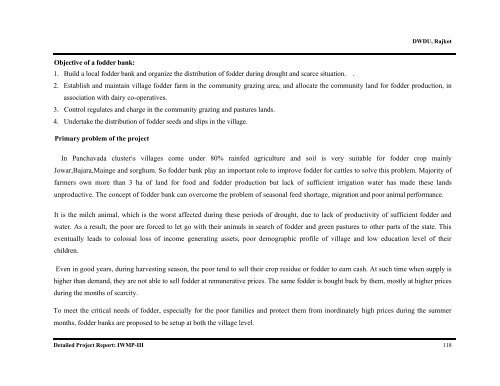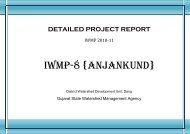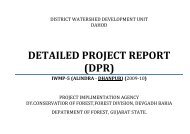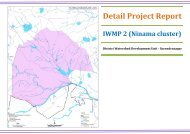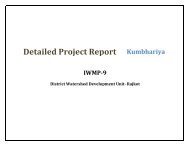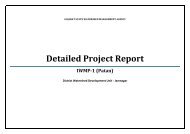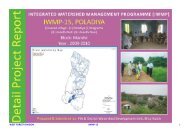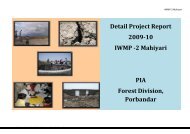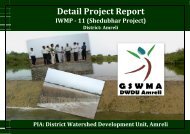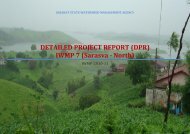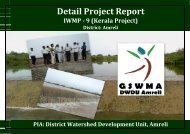IWMP-3 - Commissionerate of Rural Development Gujarat State ...
IWMP-3 - Commissionerate of Rural Development Gujarat State ...
IWMP-3 - Commissionerate of Rural Development Gujarat State ...
You also want an ePaper? Increase the reach of your titles
YUMPU automatically turns print PDFs into web optimized ePapers that Google loves.
DWDU, Rajkot<br />
Objective <strong>of</strong> a fodder bank:<br />
1. Build a local fodder bank and organize the distribution <strong>of</strong> fodder during drought and scarce situation. .<br />
2. Establish and maintain village fodder farm in the community grazing area, and allocate the community land for fodder production, in<br />
association with dairy co-operatives.<br />
3. Control regulates and charge in the community grazing and pastures lands.<br />
4. Undertake the distribution <strong>of</strong> fodder seeds and slips in the village.<br />
Primary problem <strong>of</strong> the project<br />
In Panchavada cluster\s villages come under 80% rainfed agriculture and soil is very suitable for fodder crop mainly<br />
Jowar,Bajara,Mainge and sorghum. So fodder bank play an important role to improve fodder for cattles to solve this problem. Majority <strong>of</strong><br />
farmers own more than 3 ha <strong>of</strong> land for food and fodder production but lack <strong>of</strong> sufficient irrigation water has made these lands<br />
unproductive. The concept <strong>of</strong> fodder bank can overcome the problem <strong>of</strong> seasonal feed shortage, migration and poor animal performance.<br />
It is the milch animal, which is the worst affected during these periods <strong>of</strong> drought, due to lack <strong>of</strong> productivity <strong>of</strong> sufficient fodder and<br />
water. As a result, the poor are forced to let go with their animals in search <strong>of</strong> fodder and green pastures to other parts <strong>of</strong> the state. This<br />
eventually leads to colossal loss <strong>of</strong> income generating assets, poor demographic pr<strong>of</strong>ile <strong>of</strong> village and low education level <strong>of</strong> their<br />
children.<br />
Even in good years, during harvesting season, the poor tend to sell their crop residue or fodder to earn cash. At such time when supply is<br />
higher than demand, they are not able to sell fodder at remunerative prices. The same fodder is bought back by them, mostly at higher prices<br />
during the months <strong>of</strong> scarcity.<br />
To meet the critical needs <strong>of</strong> fodder, especially for the poor families and protect them from inordinately high prices during the summer<br />
months, fodder banks are proposed to be setup at both the village level.<br />
Detailed Project Report: <strong>IWMP</strong>-III 118


